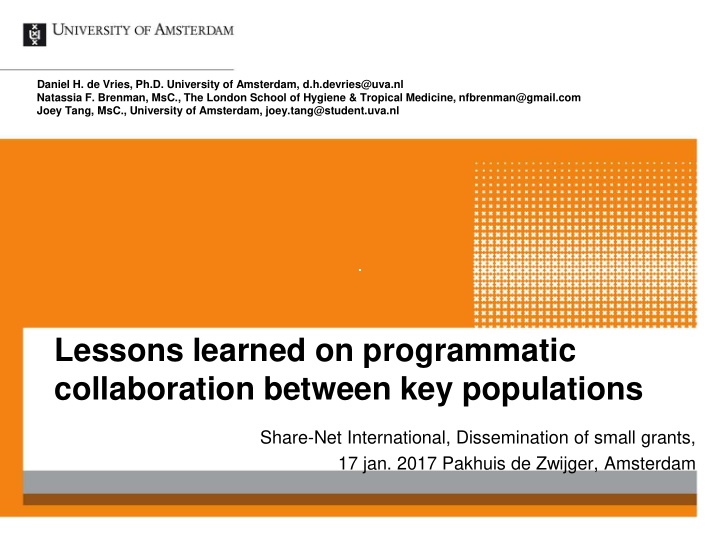



Daniel H. de Vries, Ph.D. University of Amsterdam, d.h.devries@uva.nl Natassia F. Brenman, MsC., The London School of Hygiene & Tropical Medicine, nfbrenman@gmail.com Joey Tang, MsC., University of Amsterdam, joey.tang@student.uva.nl Lessons learned on programmatic collaboration between key populations Share-Net International, Dissemination of small grants, 17 jan. 2017 Pakhuis de Zwijger, Amsterdam
Technical Brief: http://www.hivgaps. org/resources/public ations/ Type the footer here 2
Crossover Collaboration: Bridging the Gaps 3
Research questions What are the lessons learned regarding ‘horizontal’ collaboration across key population organizations? Have the various partners at local, national and global levels collaborated across key populations? If yes: who, why, how, when, about what? What were the benefits? What were the main challenges? If there wasn’t any collaboration, why not? Participant recommendations for future collaboration What are the lessons learned regarding ‘vertical’ collaboration between global-level networks, including members of the Dutch alliance, and in-country partners? Sub-questions as above
Mixed methods 45 qualitative interviews at all levels & 2 focus groups with NGO staff from various countries Field site visits in Kyrgyzstan and Kenya Participant observation at Aids Fonds (lead) and two major stakeholder meetings Online survey to 92 partners (67% response rate) Social network mapping and analysis Type the footer here 5
Working together in a diverse alliance
Working together in a diverse alliance
Explicit dimensions of difference Crossover Collaboration: Bridging the Gaps 8
well.. yes collaboration increased! 9
A forced marriage? Photo: Aids Fonds Crossover Collaboration: Bridging the Gaps 10
“We have some common points to share, but to work with three groups in only one space - men who have sex with men don't want to hang around with drug users. And a drug user - they will not mess around with gays. And that’s why it’s better to work separately.” Photo: Aids Fonds Crossover Collaboration: Bridging the Gaps 11
“I think the reason why people did not have the idea of working together was a lack of understanding of each other. Because I looked myself like a sex worker, and this is a problem I’m facing together with my sisters. I did not look at that [MSM] brother who was behind them, because that brother did not matter at that time.” Photo: Aids Fonds Crossover Collaboration: Bridging the Gaps 12
Crossover collaborationn Crossover Collaboration: Bridging the Gaps 13
“A sense of the dynamics much larger than Bridging the Gaps, which has taken them “What is great about that and put them within one structure.” is the opening up of the mind to diversity. Really understanding the meaning and the beauty maybe. Because I am not sure if it is about effectiveness at this point. Well, yeah you give a training with somebody else, but that is not going to change much. But just the fact that you are with each other”. Photo: Aids Fonds Crossover Collaboration: Bridging the Gaps 14
“Now we have found some joint interests and joint problems. Right now we are working on the anti-discrimination law, without indicating whether this is an MSM, a sex worker, or LGBT group… there should be one movement to stop discrimination.” Photo: Aids Fonds Crossover Collaboration: Bridging the Gaps 15
The link between drug users and sex workers is more easy on the ground, because a lot of drug users engage in sex work and a lot of sex workers use drugs for different reasons. So that link is quite natural.” “For example if our organisation only works with SW, but if we have some doubt that we cannot provide some service for SW using drugs— it’s not like we have doubts, but we cannot do syringe exchanges and we cannot provide those services. Then we refer our clients to other orgs where they can find such services.” Photo: Aids Fonds Crossover Collaboration: Bridging the Gaps 16
Key challenges of collaborating across diverse partners Identity politics and protectionism of own group Working in ‘silos’ Questioning the added value of other partners Failure to understand the different “hats” partners might wear within the programme Photo: Danny de Vries
Crossover Collaboration: Bridging the Gaps 18
Model design: Matt Morasky Crossover Collaboration: Bridging the Gaps 19
Conclusion (1) Despite heated debates and struggles, mutual stigma, perceptions of silo’s and identity politics, BtG successfully created a crossover collaboration that pragmatically improved service delivery. Moreover, the alliance fostered a key feeling of belonging to a movement that opened understanding and discussion regarding the value of difference and the need to find common ground by appreciating diversity. Crossover Collaboration: Bridging the Gaps 20
Conclusion (2) We believe the intersectional approach to collaboration we used to develop a conceptual model of differences may help alliance partners to recognize when identity politics is at play, and realise that these identities are not essential but positional , and at times part of the shifting hats needed to be productive. To collaborate effectively across difference, we learn that different identities need to respectfully “agree to disagree” on certain differences, yet continue to make efforts to seek common ground by exploring connections elsewhere. Type the footer here 21
Discussion question But how to agree to disagree and shift hats? How to utilize intersectionality productively in partnerhip contexts? We believe that developing this type of skill takes time and is ideally initiated as major activity at the very beginning of each new or revised collaboration. However, the programmatic politics of dividing up “the pie” of funding at the beginning of many collaborations prevents true exploration of “hats”, roles, positions and common goals. How can this vicious cycle be broken? Type the footer here 22
Recommend
More recommend